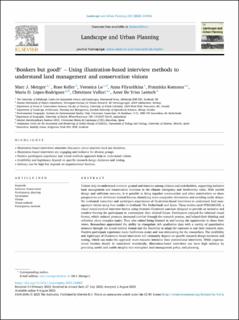‘Bonkers but good!’ – Using illustration-based interview methods to understand land management and conservation visions
Metzger, Marc J.; Keller, Rose; Lo, Veronica; Filyushkina, Anna; Komossa, Franziska; Lopez-Rodrıguez, Marıa D.; Valluri, Christiane; De Vries Lentsch, Aster
Peer reviewed, Journal article
Published version

Åpne
Permanent lenke
https://hdl.handle.net/11250/3084732Utgivelsesdato
2023Metadata
Vis full innførselSamlinger
- Publikasjoner fra CRIStin - NINA [2364]
- Scientific publications [1392]
Originalversjon
10.1016/j.landurbplan.2023.104862Sammendrag
Forest biodiversity studies conduct Visions help to understand common ground and tensions among citizens and stakeholders, supporting inclusive land management and conservation solutions to the climate emergency and biodiversity crisis. With careful design and sufficient resource, it is possible to bring together communities and other stakeholders to share perspectives and deliberate desired futures, identifying more acceptable alternatives and avoiding costly delays. We evaluated researcher and participant experiences of illustration-based interviews to understand land management visions using four studies in Scotland, The Netherlands and Spain. These studies used STREAMLINE, a visual mixed-method interview format using thematic illustrated canvases designed to provide an inclusive and creative framing for participants to contemplate their desired future. Participants enjoyed the informal visual format, which reduced pressure, increased comfort through the research process, and helped their thinking and reflection about complex topics. They also valued being listened to and having the opportunity to share their views. Researchers appreciated the ability to triangulate rich qualitative data with a variety of quantitative measure through the mixed-method format and the flexibility to adapt the canvases to suit their research aims. Positive participant experience made facilitation easier and was stimulating for the researchers. The credibility and legitimacy of illustration-based interviews will ultimately depend on specific research design-decisions and testing, which can make the approach more resource intensive than conventional interviews. While organisal barriers should be considered realistically, illustration-based interviews can have high saliency by providing useful and usable insights that strengthen land management policy and planning. Inclusive Conservation Participatory planning Governance Visions Visual methods Participatory methods d across Europe use a multitude of forestry terms, often inconsistently. This hinders the comparability across studies and makes the assessment of the impacts of forest management on biodiversity highly context-dependent. Recent attempts to standardize forestry and stand description terminology mostly used a top-down approach that did not account for the perspectives and approaches of forest biodiversity experts. This work aims to establish common standards for silvicultural and vegetation definitions, creating a shared conceptual framework for a consistent study on the effects of forest management on biodiversity. We have identified both strengths and weaknesses of the silvicultural and vegetation information provided in forest biodiversity studies. While quantitative data on forest biomass and dominant tree species are frequently included, information on silvicultural activities and vegetation composition is often lacking, shallow, or based on broad and heterogeneous classifications. We discuss the existing classifications and their use in European forest biodiversity studies through a novel bottom-up and top-driven review process, and ultimately propose a common framework. This will enhance the comparability of forest biodiversity studies in Europe, and puts the basis for effective implementation and monitoring of sustainable forest management policies. The standards here proposed are potentially adaptable and applicable to other geographical areas and could be extended to other forest interventions.
